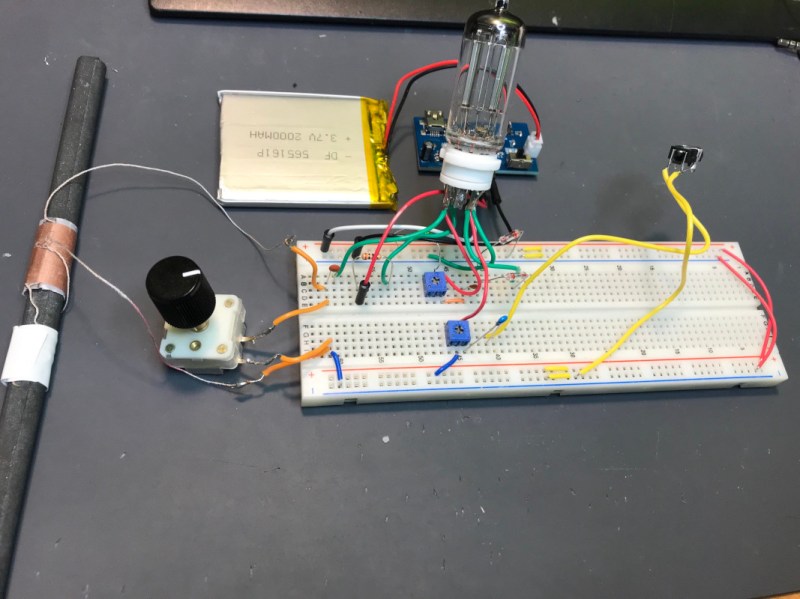Before the invention of transistors, vacuum tubes ruled the world. The only way to get amplification or switching (or any electrical control of current) back then was to use tubes. But some tube design limitations were obvious even then. For one, they produce an incredible amount of heat during normal operation, which leads to reliability issues. Tubes were difficult to miniaturize. Thankfully transistors solved all of these issues making vacuum tubes obsolete, but if you want to investigate the past a little bit there are still a few tubes on the market.
[kodera2t] was able to get his hands on a few of these, and they seem to be relatively new. This isn’t too surprising; there are some niche applications where tubes are still used. These have some improvements over their ancestors too, operating at only 30V compared to hundreds of volts for some older equipment. [kodera2t] takes us through a few circuits built with these tubes, from a simple subminiature vacuum tube radio to a more complex reflex radio.
Taking a walk through this history is an interesting exercise, and it’s worth seeing the ways that transistor-based circuits differ from tube-based circuits. If you’re interested enough to move on beyond simple radio circuits, though, you can also start building your own audio equipment with vacuum tubes.
















” Tubes were difficult to miniaturize. ”
Hope not.
https://www.extremetech.com/extreme/185027-the-vacuum-tube-strikes-back-nasas-tiny-460ghz-vacuum-transistor-that-could-one-day-replace-silicon-fets
Or smaller.
https://www.berkeley.edu/news/media/releases/2007/10/31_NanoRadio.shtml
The articel describes a device that seems to work on the same principles as a vacuum tube, but the phrase “thermionic emission” is strangely absent.
The article gave me that “crystal set” vibe.
I remember back in the old days, back when Al Gore invented the internet with a series of tubes.
I think they were 12AT7s.
You may be correct.. +1
Hyuck, hyuck, hyuck .. good one .. hyuck
https://www.snopes.com/fact-check/internet-of-lies/
Al Gore did not invent the internet! For the last time. Al Gore invented pornography, and the internet was developed as the propagation medium.
Just for the record:
(1) Snopes is not always truthful. (There is no reliable department of truth, which is a good thing. If there was, it would quickly become corrupted by human depravity and would cease to be an true authority.)
(2) Al gore did what Democrat US senators do best, spend the American people’s money and that was what he did while leading the approval to spend money to establish a public, non-research/military-exclusive internet. He didn’t do any engineering, but knew to spend money to preserve what had already been built but was going to be ab abandoned as the military moved on to a different network. Hell, even a broken analog clock is right twice a day and he was right at that time. (pretty well the only time, though) Though it pains me, I think credit needs to be given to him for helping establish the internet.
“only way to get amplification or switching (or any electrical control of current) back then was to use tubes”… “produce an incredible amount of heat”… reliability issues”… “difficult to miniaturize”. Sigh; this article has many misconceptions about tubes.
We had magnetic amps and relay switching long before tubes were invented.
Tubes for portable radios (like the 1R5 in the article) produce so little heat that you can barely tell they are on.
Whole families of tubes were built for direct 12v operation in car radios. See http://www.junkbox.com/electronics/lowvoltagetubes.shtml for examples.
There were many subminiature tubes (like the 6CW4) the size of a pencil eraser.
VFDs (Vacuum Fluorescent Displays) are an example of tube integrated circuits, with thousands of tiny triodes in one device.
Pretending that one tube’s shortcomings is representative of all tubes is like pretending that the Ford Model T is representative of all automobiles.
Beat me to a lot of those. Also, audio amplifiers could be made by mechanically coupling a transducer, for example, the guts from an electromagnetic headphone to a carbon button microphone. Not the best frequency response, and probably electrically noisy, but I understand that they worked.
Why are some risking breaking an arm patting themselves on the back ?I’m certain that the nuvistor was practical component, fer the FET was. My read of the history of the telephone, agrees with Mr. Buchanan’s comment about acoustically coupled “amplifiers”. Around I do haveve some small vacuum tube that a insulated lead exiting the glass envelope
Bryan Cockfield clearly has no idea what he is talking about. Most of the “statements” made here about tubes, are flat out incorrect.
I agree, lack of knowledge on the tube part. Maybe he should check out Audio Research and McIntosh both still produce tube amplifiers and many more. Next do a search for a 300 b tube by WE nice prices for a 70 +year old tube. Tubes are still being made by Germany, Russia and China. It is a huge market and it is growing nothing like the glow of a power tube.
More beer!